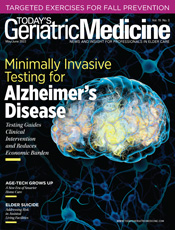
May/June 2022
From the Editor: Preventing Suicide in Older Adults Common circumstances of aging and age-related illnesses—including grief, loneliness, pain, cognitive deficits, financial instability, depression, and a fear of becoming a burden on others—put older adults at risk for suicide. While older patients make up only 12% of the population, they’re involved in 18% of suicides. In 2017, 8,500 of the more than 47,000 suicides that took place in the United States were by people 65 and older, according to the National Council on Aging, with many cases likely unreported. Men are at greatest risk, especially those older than 85. Furthermore, double suicides involving partners, while rare, are more likely to occur among the elderly. While 1 in 200 youths will die as a result a suicide attempt, 1 in 4 older adults die after an attempt. Among the reasons older adults are more likely than younger individuals to die as a result of a suicide attempt are that they’re more likely to carefully plan, they use more lethal methods, they’re less likely to be discovered and rescued, and, due to frailty, they may be less able to recover from injuries associated with an attempt. Health care providers not only need to be alert to the signs and screen older patients for suicide risk but also must inquire about patients’ mental health, help patients access mental health care, provide resources and information about suicide prevention, and be aware of substance use, psychiatric disorders, social isolation, the presence of firearms in the home, and other risk factors. Statistics suggest that many older adults who die by suicide saw a health care provider in the month before their deaths. Although they likely discussed a physical ailment, a conversation about mental health might have alerted a provider to a vulnerability and resulted in an actionable plan to prevent suicide. Providers can’t afford to miss an opportunity to screen vulnerable older adults and perhaps make the difference that will save lives. In this issue, Frank Amato explores the risk of suicide among residents of assisted living facilities, more than one-half of whom are older than 85, putting them in the highest category of risk. He explores the risks, details the signs, and describes the ways that assisted living facilities can play a significant role in suicide prevention. |
